Winter Wheat Yield Estimation Based on Multi-Temporal and Multi-Sensor Remote Sensing Data Fusion
Abstract
:1. Introduction
2. Materials and Methods
2.1. Study Area Overview
2.2. Data Collection
2.2.1. Remote Sensing Data Acquisition and Preprocessing
2.2.2. Winter Wheat Yield Determination
2.3. Calculation and Selection of Color Indexes and Multispectral Vegetation Indexes
2.4. Data Analysis Methods
3. Results
3.1. In-Field Measurement of Winter Wheat Yield
3.2. Significant Analysis of the Effect of Multispectral Vegetation Indexes and Color Indexes on Yield
3.3. Yield Estimation Models Based on Multiple Growth Periods
4. Discussion
5. Conclusions
Author Contributions
Funding
Institutional Review Board Statement
Data Availability Statement
Acknowledgments
Conflicts of Interest
References
- Sishodia, R.P.; Ray, R.L.; Singh, S.K. Applications of remote sensing in precision agriculture: A review. Remote Sens. 2020, 12, 3136. [Google Scholar] [CrossRef]
- Boursianis, A.D.; Papadopoulou, M.S.; Diamantoulakis, P.; Liopa-Tsakalidi, A.; Barouchas, P.; Salahas, G.; Karagiannidis, G.; Wan, S.; Goudos, S.K. Internet of things (IoT) and agricultural unmanned aerial vehicles (UAVs) in smart farming: A comprehensive review. Internet Things 2022, 18, 100187. [Google Scholar] [CrossRef]
- Yu, F.H.; Cao, Y.L.; Xu, T.Y.; Guo, Z.H.; Wang, D.K. Precision fertilization by UAV for rice at tillering stage in cold region based on hyperspectral remote sensing prescription map. Trans. CSAE. 2020, 36, 103–110. [Google Scholar]
- Zhou, M.G.; Shao, G.M.; Zhang, L.Y.; Yao, X.M.; Han, W. T Inversion of SPAD value of winter wheat by multispectral remote sensing of unmanned aerial vehicles. Trans. Chin. Soc. Agric. Eng. 2020, 36, 125–133. [Google Scholar]
- Corti, M.; Cavalli, D.; Cabassi, G.; Vigoni, A.; Degano, L.; Marino Gallina, P. Application of a low-cost camera on a UAV to estimate maize nitrogen-related variables. Precis. Agric. 2019, 20, 675–696. [Google Scholar] [CrossRef]
- Dai, J.G.; Jiang, N.; Xue, J.L.; Zhang, G.S.; He, X.L. Method for predicting cotton yield based on CNN-BiLSTM. Trans. CSAE 2021, 37, 152–159. [Google Scholar]
- Escalante, H.J.; Rodríguez-Sánchez, S.; Jiménez-Lizárraga, M.; Morales-Reyes, A.; De La Calleja, J.; Vazquez, R. Barley yield and fertilization analysis from UAV imagery: A deep learning approach. Int. J. Remote Sens. 2019, 40, 2493–2516. [Google Scholar] [CrossRef]
- Diacono, M.; Rubino, P.; Montemurro, F. Precision nitrogen management of wheat. A review. Agron. Sustain. Dev. 2013, 33, 219–241. [Google Scholar] [CrossRef]
- Camino, C.; González-Dugo, V.; Hernández, P.; Sillero, J.C.; Zarco-Tejada, P.J. Improved nitrogen retrievals with airborne-derived fluorescence and plant traits quantified from VNIR-SWIR hyperspectral imagery in the context of precision agriculture. Int. J. Appl. Earth Obs. Geoinf. 2018, 70, 105–117. [Google Scholar] [CrossRef]
- Tao, H.; Xu, L.; Feng, H.; Yang, G.J.; Yang, X.D.; Niu, Y.C. Winter wheat yield estimation based on UAV hyperspectral remote sensing data. Trans. Chin. Soc. Agric. Mach. 2020, 51, 146–155. [Google Scholar]
- Li, J.; Veeranampalayam-Sivakumar, A.N.; Bhatta, M.; Garst, N.D.; Stoll, H.; Stephen Baenziger, P.; Belamkar, V.; Howard, R.; Ge, Y.; Shi, Y. Principal variable selection to explain grain yield variation in winter wheat from features extracted from UAV imagery. Plant Methods 2019, 15, 123. [Google Scholar] [CrossRef] [PubMed]
- Song, X.; Zhang, G.; Liu, F.; Li, D.; Zhao, Y.; Yang, J. Modeling spatio-temporal distribution of soil moisture by deep learning-based cellular automata model. J. Arid. Land 2016, 8, 734–748. [Google Scholar] [CrossRef]
- Chlingaryan, A.; Sukkarieh, S.; Whelan, B. Machine learning approaches for crop yield prediction and nitrogen status estimation in precision agriculture: A review. Comput. Electron. Agric. 2018, 151, 61–69. [Google Scholar] [CrossRef]
- Van Klompenburg, T.; Kassahun, A.; Catal, C. Crop yield prediction using machine learning: A systematic literature review. Comput. Electron. Agric. 2020, 177, 105709. [Google Scholar] [CrossRef]
- Zhou, Y.; Wang, D.; Chen, C.; Li, R.; Li, D. Prediction of wheat yield based on color index and texture feature index of unmanned aerial vehicle rgb image. J. Yangzhou Univ. 2021, 42, 110–116. [Google Scholar]
- Liu, X.Y.; Zhong, X.C.; Chen, C.; Liu, T.; Sun, C.M.; Li, D.S. Prediction of wheat yield using color and texture feature data of UAV image at early growth stage. J. Triticeae Crop. 2020, 40, 1002–1007. [Google Scholar]
- Yang, J.; Ding, F.; Chen, C.; Liu, T.; Sun, C.M.; Ding, D.W.; Huo, Z.Y. Correlation of wheat biomass and yield with UAV image characteristic parameters. Trans. Chin. Soc. Agric. Eng. 2019, 35, 104–110. [Google Scholar]
- Song, C.Y.; Geng, H.W.; Fei, S.P.; Li, L.; Gan, T.; Zeng, C.W.; Xiao, Y.G.; Tao, Z.Q. Study on Yield Estimation of Wheat Varieties Based onMulti-Source Data. Spectrosc. Spectr. Anal. 2023, 43, 2210–2219. [Google Scholar]
- Cheng, Q.; Xu, H.; Cao, Y.; Duan, F.; Chen, Z. Grain Yield Prediction of Winter Wheat Using Multi-temporal UAV Based on Multispectral Vegetation Index. Trans. Chin. Soc. Agric. Mach. 2021, 52, 160–167. [Google Scholar]
- Han, W.; Peng, X.; Zhang, L.; Niu, Y. Summer maize yield estimation based on vegetation index derived from multi-temporal UAV remote sensing. Trans. Chin. Soc. Agric. Mach. 2020, 51, 149–155. [Google Scholar]
- Zhou, X.; Zheng, H.B.; Xu, X.Q.; He, J.Y.; Ge, X.K.; Yao, X.; Cheng, T.; Zhu, Y.; Cao, W.X.; Tian, Y.C. Predicting grain yield in rice using multi-temporal vegetation indices from UAV-based multispectral and digital imagery. ISPRS J. Photogramm. Remote Sens. 2017, 130, 246–255. [Google Scholar] [CrossRef]
- Zhou, J.; Wang, D.; Maroufpoor, S.; Band, S.S. Sensitivity analysis of wheat yield based on growing degree days in different growth stages: Application of machine learning approach enhanced by grey systems theory. Comput. Electron. Agric. 2023, 210, 107876. [Google Scholar] [CrossRef]
- Han, J.; Zhang, Z.; Cao, J.; Luo, Y.; Zhang, L.; Li, Z.; Zhang, J. Prediction of winter wheat yield based on multi-source data and machine learning in China. Remote Sens. 2020, 12, 236. [Google Scholar] [CrossRef]
- Bian, C.; Shi, H.; Wu, S.; Zhang, K.; Wei, M.; Zhao, Y.; Sun, Y.; Zhuang, H.; Zhang, X.; Chen, S. Prediction of field-scale wheat yield using machine learning method and multi-spectral UAV data. Remote Sens. 2022, 14, 1474. [Google Scholar] [CrossRef]
- Wan, L.; Cen, H.; Zhu, J.; Zhang, J.; Zhu, Y.; Sun, D.; Du, X.; Zhai, L.; Weng, H.; Li, Y.; et al. Grain yield prediction of rice using multi-temporal UAV-based RGB and multispectral images and model transfer–a case study of small farmlands in the South of China. Agric. For. Meteorol. 2020, 291, 108096. [Google Scholar] [CrossRef]
- Xue, J.; Su, B. Significant remote sensing vegetation indices: A review of developments and applications. J. Sens. 2017, 2017, 1353691. [Google Scholar] [CrossRef]
- Davidson, C.; Jaganathan, V.; Sivakumar, A.N.; Czarnecki, J.M.P.; Chowdhary, G. NDVI/NDRE prediction from standard RGB aerial imagery using deep learning. Comput. Electron. Agric. 2022, 203, 107396. [Google Scholar] [CrossRef]
- Shanmugapriya, P.; Rathika, S.; Ramesh, T.; Janaki, P. Applications of remote sensing in agriculture-A Review. Int. J. Curr. Microbiol. Appl. Sci. 2019, 8, 2270–2283. [Google Scholar] [CrossRef]
- Fern, R.R.; Foxley, E.A.; Bruno, A.; Morrison, M.L. Suitability of NDVI and OSAVI as estimators of green biomass and coverage in a semi-arid rangeland. Ecol. Indic. 2018, 94, 16–21. [Google Scholar] [CrossRef]
- Zhang, T.; Xiu, J.I.N.; Yuan, R.A.O. Inversing photosynthesis quantum yield of the soybean flag leaf using a UAV-carrying multispectral camera. Trans. CSAE. 2022, 38, 150–157. [Google Scholar]
- Pearson, R.L.; Miller, L.D. Remote mapping of standing crop biomass for estimation of the productivity of the shortgrass prairie. Remote Sens. Environ. 1972, VIII, 1355. [Google Scholar]
- Gitelson, A.A.; Viña, A.; Ciganda, V.; Rundquist, D.C.; Arkebauer, T.J. Remote estimation of canopy chlorophyll content in crops. Geophys. Res. Lett. 2005, 32. [Google Scholar] [CrossRef]
- Pen Uelas, J.; Filella, I.; Lloret, P.; Mun Oz, F.; Vilajeliu, M. Reflectance assessment of mite effects on apple trees. Int. J. Remote Sens. 1995, 16, 2727–2733. [Google Scholar] [CrossRef]
- Barbedo, J.G.A. Detection of nutrition deficiencies in plants using proximal images and machine learning: A review. Comput. Electron. Agric. 2019, 162, 482–492. [Google Scholar] [CrossRef]
- Woebbecke, D.M.; Meyer, G.E.; Von Bargen, K.; Mortensen, D.A. Plant Species Identification, Size, and Enumeration Using Machine Vision Techniques on Near-Binary Images. In Optics in Agriculture and Forestry; SPIE: Bellingham, WA, USA, 1993; Volume 1836, pp. 208–219. [Google Scholar]
- Mao, D.; Wu, X.; Deppong, C.; Friend, L.D.; Dolecki, G.; Nelson, D.M.; Molina, H. Negligible role of antibodies and C5 in pregnancy loss associated exclusively with C3-dependent mechanisms through complement alternative pathway. Immunity 2003, 19, 813–822. [Google Scholar] [CrossRef]
- Louhaichi, M.; Borman, M.M.; Johnson, D.E. Spatially located platform and aerial photography for documentation of grazing impacts on wheat. Geocarto Int. 2001, 16, 65–70. [Google Scholar] [CrossRef]
- Bendig, J.; Yu, K.; Aasen, H.; Bolten, A.; Bennertz, S.; Broscheit, J.; Gnyp, M.L.; Bareth, G. Combining UAV-based plant height from crop surface models, visible, and near infrared vegetation indices for biomass monitoring in barley. Int. J. Appl. Earth Obs. Geoinf. 2015, 39, 79–87. [Google Scholar] [CrossRef]
- Wan, L.; Du, X.; Chen, S.; Yu, F.; Zhu, J.; Xu, T.; He, Y.; Cen, H. Rice panicle phenotyping using UAV-based multi-source spectral image data fusion. Trans. Chin. Soc. Agric. Eng. 2022, 38, 162–170. [Google Scholar]
- Penuelas, J.; Baret, F.; Filella, I. Semi-empirical indices to assess carotenoids/chlorophyll a ratio from leaf spectral reflectance. Photosynthetica 1995, 31, 221–230. [Google Scholar]
- Zhou, K.; Zhou, T.; Ding, F.; Ding, D.W.; Wu, W.; Yao, Z.S.; Liu, T.; Huo, Z.Y.; Sun, C.M. Wheat LAI Estimation in Main Growth Period Based on UAV Images. J. Agric. Sci. Technol. 2021, 23, 89–97. [Google Scholar]
- Jiang, J.; Zhang, Z.Y.; Cao, Q.; Tian, Y.C.; Zhu, Y.; Cao, W.X.; Liu, X.J. Use of a digital camera mounted on a consumer-grade unmanned aerial vehicle to monitor the growth status of wheat. J. Nanjing Agric. Univ. 2019, 42, 622–631. [Google Scholar]
- Tao, H.; Feng, H.; Yang, G.; Yang, X.; Miao, M.; Wu, Z.; Zhai, L. Comparison of winter wheat yields estimated with UAV digital image and hyperspectral data. Trans. Chin. Soc. Agric. Eng. 2019, 35, 111–118. [Google Scholar]
- Fan, J.L.; Wang, H.; Liao, Z.Q.; Dai, Y.L.; Yu, J.; Feng, H.L. Winter Wheat Leaf Area Index Estimation Based on Texture-color Features and Vegetation Indices. Trans. Chin. Soc. Agric. Mach. 2023, 54, 347–359. [Google Scholar]
- Liu, C.B.; Xing, S.; Wang, D.D.; Li, P.C.; Chen, K.; Wu, L.T. Absorption Coefficients Inversion Model Based on Gaussian Process Regression. J. Geomat. Sci. Technol. 2021, 38, 384–390. [Google Scholar]
- Lou, S.; Yang, S.Q.; Liu, Y.; Zhang, W.F.; Lv, X.H. Effects of representative groundwater salinity and irrigation amount on the yield and quality of Lycium barbarum in the Hetao Irrigation areas. Trans. CSAE 2022, 38, 102–112. [Google Scholar]
- Liu, J.; He, X.; Wang, P.; Huang, J. Early prediction of winter wheat yield with long time series meteorological data and random forest method. Trans. CSAE 2019, 35, 158–166. [Google Scholar]
- Wang, P.; Tian, H.; Zhang, Y.; Han, D.; Wang, J.; Yin, M. Crop Growth monitoring and yield estimation based on deep learning: State of the art and beyond. Trans. Chin. Soc. Agric. Mach. 2022, 53, 1–14. [Google Scholar]
- Darwin, B.; Dharmaraj, P.; Prince, S.; Popescu, D.E.; Hemanth, D.J. Recognition of bloom/yield in crop images using deep learning models for smart agriculture: A review. Agronomy 2021, 11, 646. [Google Scholar] [CrossRef]
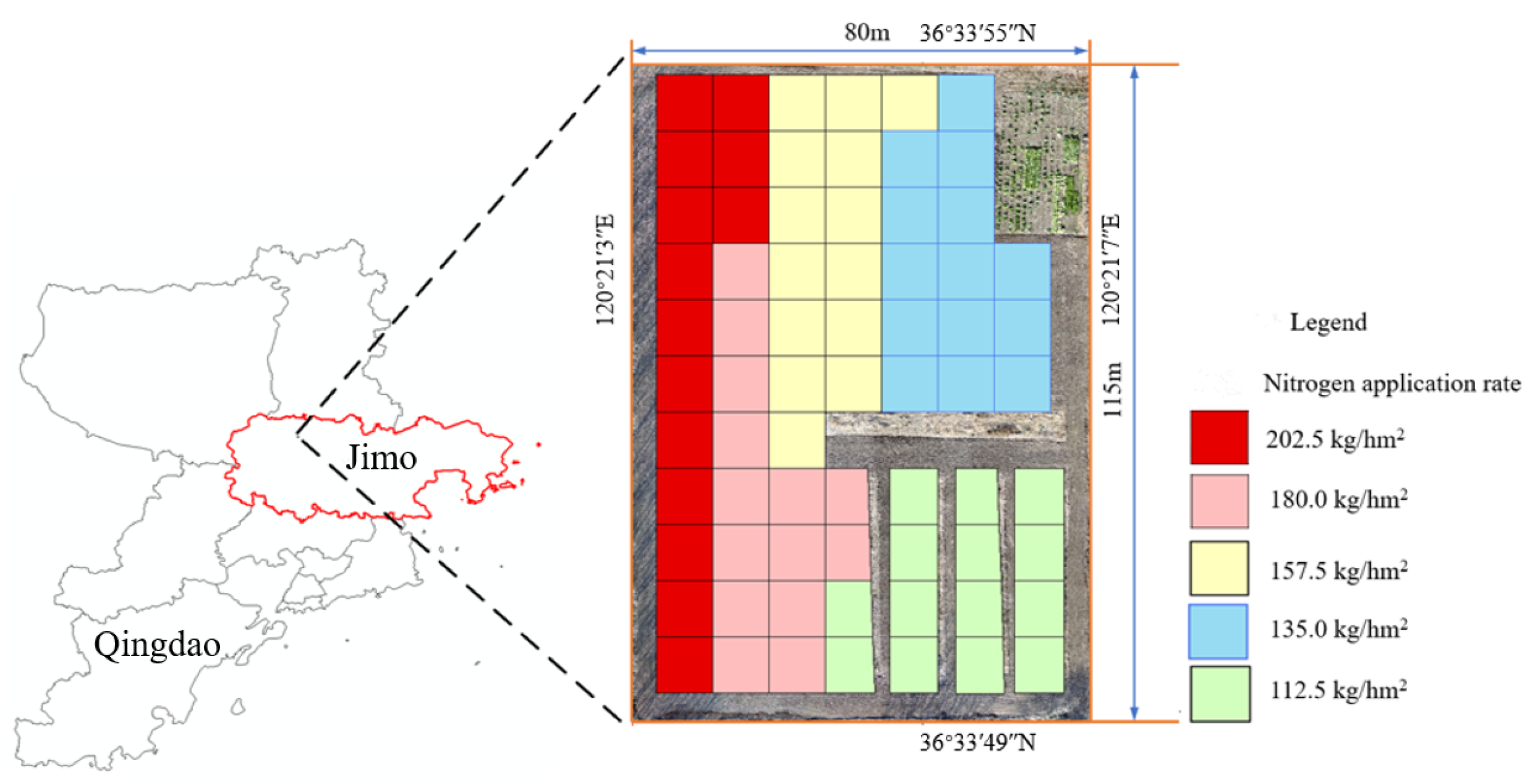
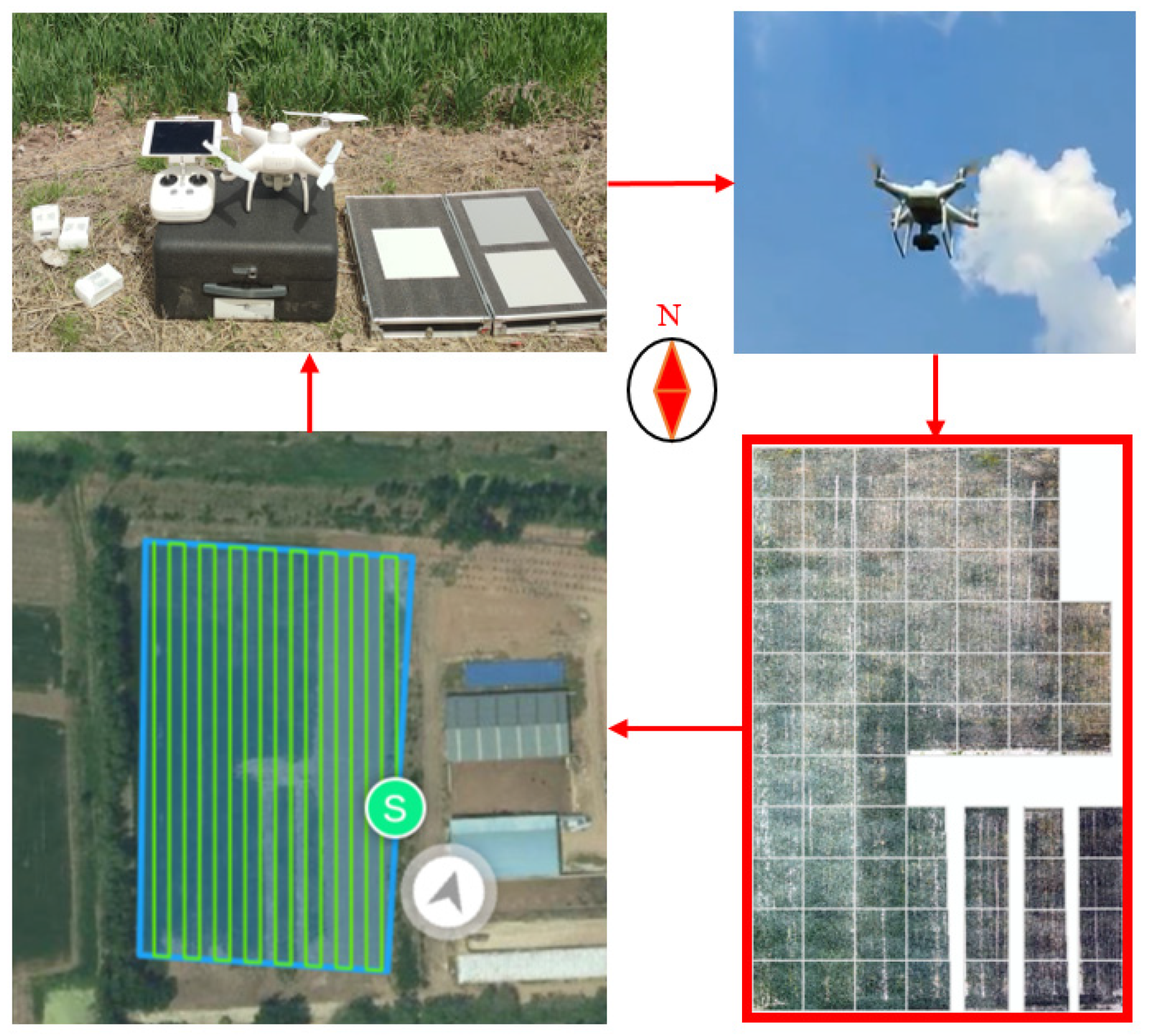
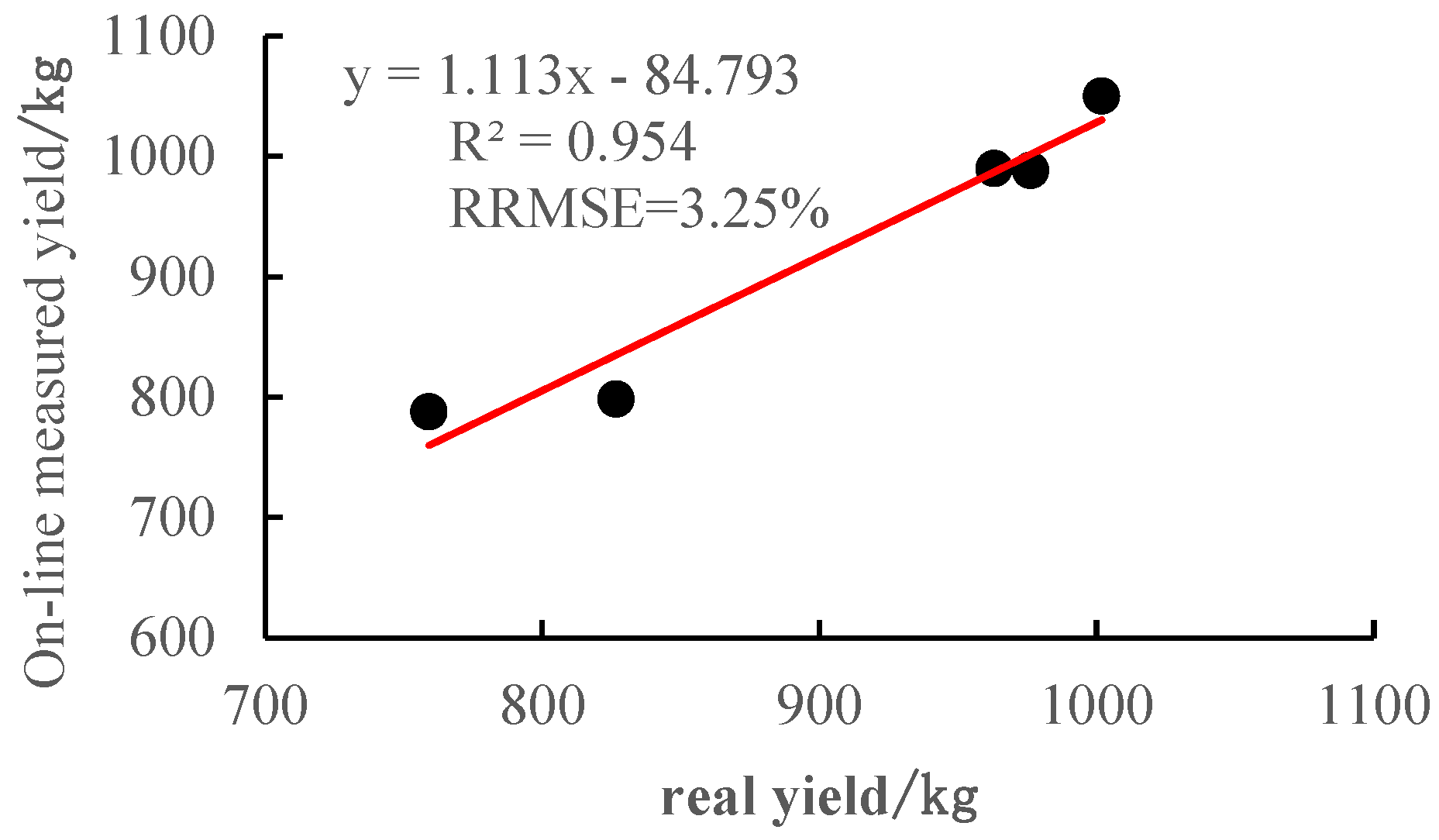

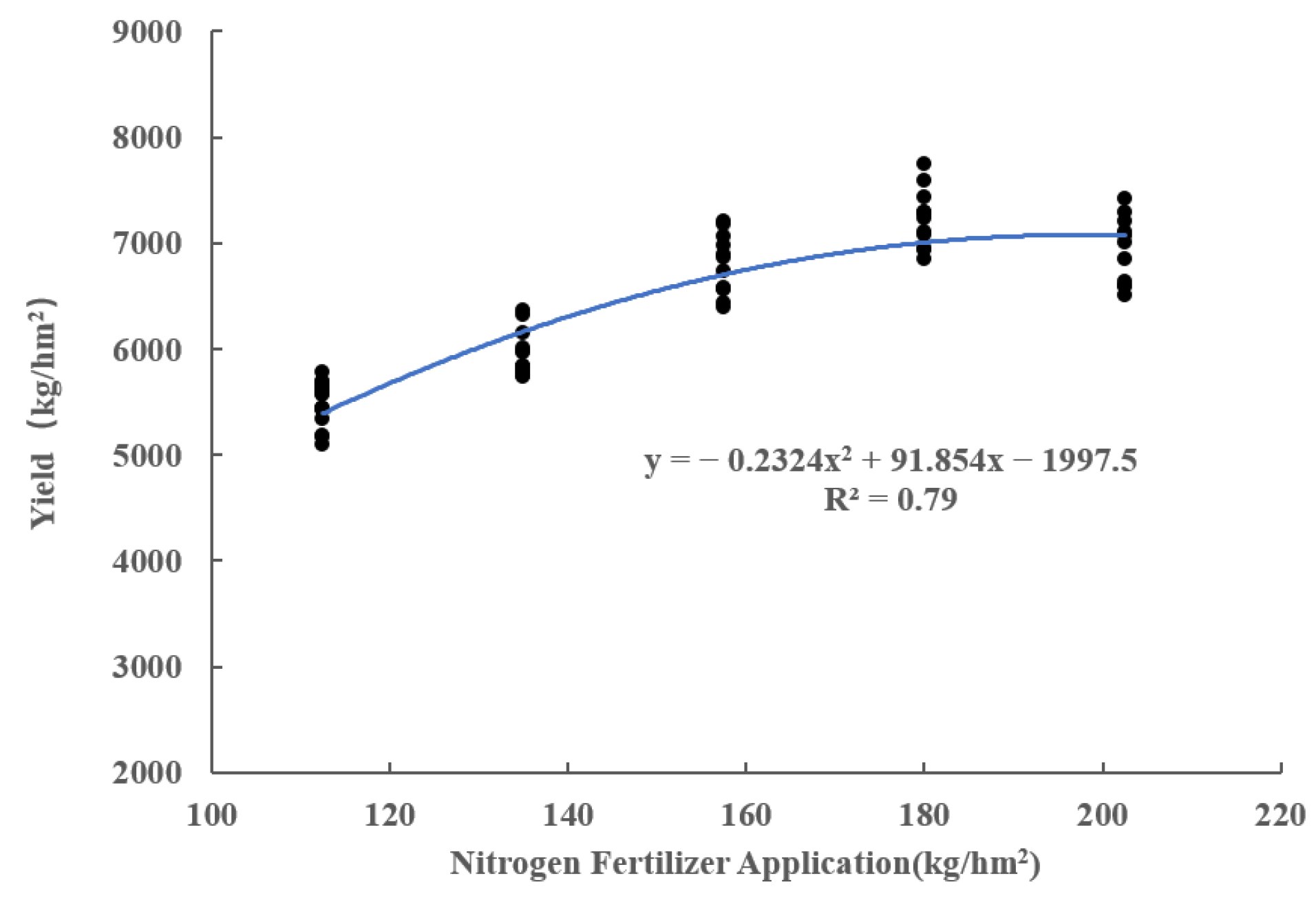
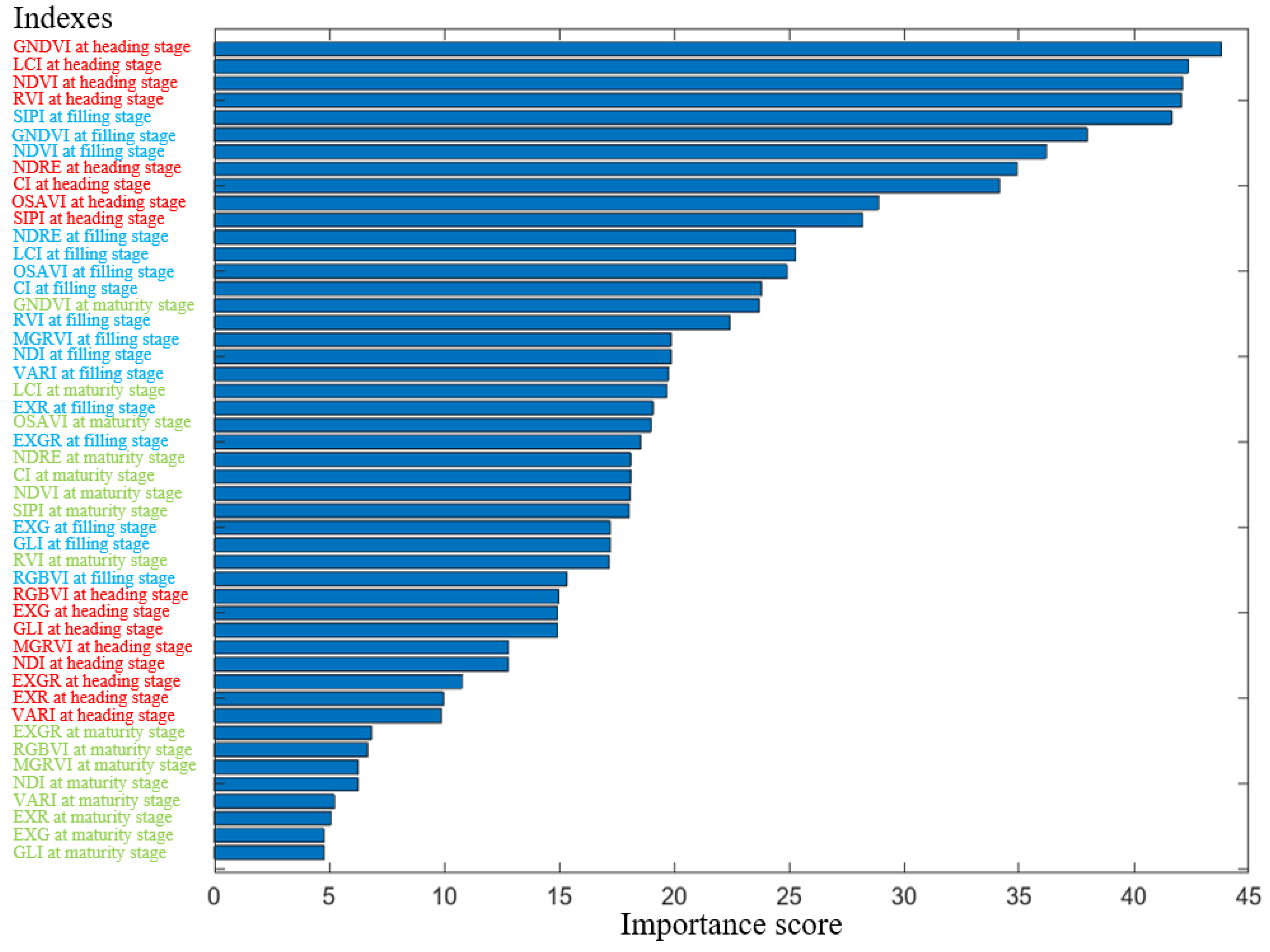

| Serial Number | Index | Formulas | Reference |
|---|---|---|---|
| 1 | NDVI | (NIR − R)/(NIR + R) | [26] |
| 2 | NDRE | (NIR − RE)/(NIR + RE) | [27] |
| 3 | GNDVI | (NIR − G)/(NIR + G) | [28] |
| 4 | OSAVI | (NIR − R)/(NIR + R + 0.16) | [29] |
| 5 | LCI | (NIR − RE)/(NIR + R) | [30] |
| 6 | RVI | NIR/R | [31] |
| 7 | CIRE | NIR/RE − 1 | [32] |
| 8 | SIPI | (NIR − B)/(NIR − R) | [33] |
| 9 | MGRVI | (g2 − r2)/(g2 + r2) | [34] |
| 10 | EXGR | ExG − ExR | [35] |
| 11 | EXR | 1.4r − g | [36] |
| 12 | NDI | (g − r)/(g + r) | [17] |
| 13 | VARI | (g − r)/(g + r − b) | [18] |
| 14 | ExG | 2g − b − r | [35] |
| 15 | GLI | (2g − b − r)/(2g + b + r) | [37] |
| 16 | RGBVI | (g2 − br)/(g2 + br) | [38] |
| Parameters | Heading Stage | Filling Stage | Maturity Stage | |||
|---|---|---|---|---|---|---|
| F Value | p Value | F Value | p Value | F Value | p Value | |
| Model/NDVI | 213.180 | <0.0001 ** | 140.713 | <0.0001 ** | 47.409 | <0.0001 ** |
| Model/GNDVI | 216.379 | <0.0001 ** | 146.275 | <0.0001 ** | 55.111 | <0.0001 ** |
| Model/NDRE | 176.709 | <0.0001 ** | 119.775 | <0.0001 ** | 51.462 | <0.0001 ** |
| Model/LCI | 196.093 | <0.0001 ** | 123.689 | <0.0001 ** | 47.713 | <0.0001 ** |
| Modell/OSAVI | 98.312 | <0.0001 ** | 88.011 | <0.0001 ** | 47.464 | <0.0001 ** |
| Model/RVI | 185.758 | <0.0001 ** | 86.690 | <0.0001 ** | 23.820 | <0.0001 ** |
| Model/SIPI | 104.440 | <0.0001 ** | 186.709 | <0.0001 ** | 72.952 | <0.0001 ** |
| Model/CIRE | 159.583 | <0.0001 ** | 104.977 | <0.0001 ** | 43.072 | <0.0001 ** |
| Model/MGRVI | 34.500 | <0.0001 ** | 78.490 | <0.0001 ** | 8.571 | 0.005 ** |
| Model/EXGR | 38.905 | <0.0001 ** | 67.754 | <0.0001 ** | 8.743 | 0.004 ** |
| Model/EXR | 30.283 | <0.0001 ** | 80.210 | <0.0001 ** | 8.264 | 0.005 ** |
| Model/NDI | 34.534 | <0.0001 ** | 78.409 | <0.0001 ** | 8.529 | 0.005 ** |
| Model/VARI | 28.617 | <0.0001** | 79.277 | <0.0001 ** | 8.755 | 0.004 ** |
| Model/ExG | 17.728 | <0.0001 ** | 50.837 | <0.0001 ** | 8.892 | 0.004 ** |
| Model/GLI | 17.885 | <0.0001 ** | 51.331 | <0.0001 ** | 8.885 | 0.004 ** |
| Model/RGBVI | 12.672 | 0.001 ** | 43.256 | <0.0001 ** | 8.892 | 0.004 ** |
| Index | DT | SVR | GPR | ||||||
|---|---|---|---|---|---|---|---|---|---|
| R2 | RMSE (kg/hm2) | rRMSE (%) | R2 | RMSE (kg/hm2) | rRMSE (%) | R2 | RMSE (kg/hm2) | rRMSE (%) | |
| RGB color indexes at the multiple growth periods | 0.68 | 412.11 | 6.50 | 0.79 | 334.06 | 5.27 | 0.80 | 330.37 | 5.21 |
| RGB color indexes at the heading stage | 0.49 | 521.09 | 8.22 | 0.53 | 502.37 | 7.92 | 0.53 | 496.89 | 7.84 |
| RGB color indexes at the filling stage | 0.54 | 491.75 | 7.76 | 0.57 | 478.85 | 7.55 | 0.59 | 463.67 | 7.31 |
| RGB color indexes at the maturity stage | 0.10 | 703.22 | 11.09 | 0.16 | 678.61 | 10.70 | 0.18 | 671.03 | 10.58 |
| Multispectral vegetation indexes at the multiple growth periods | 0.77 | 347.05 | 5.47 | 0.79 | 330.41 | 5.21 | 0.80 | 328.95 | 5.19 |
| Multispectral vegetation indexes at the heading stage | 0.76 | 354.54 | 5.59 | 0.78 | 337.32 | 5.32 | 0.79 | 331.82 | 5.23 |
| Multispectral vegetation indexes at the filling stage | 0.74 | 372.53 | 5.88 | 0.77 | 345.37 | 5.45 | 0.78 | 343.47 | 5.42 |
| Multispectral vegetation indexes at the maturity stage | 0.46 | 534.79 | 8.43 | 0.61 | 454.50 | 7.17 | 0.65 | 432.56 | 6.82 |
| Multispectral vegetation indexes + RGB color indexes at the multiple growth periods | 0.78 | 336.90 | 5.31 | 0.82 | 306.41 | 4.83 | 0.83 | 297.70 | 4.69 |
| Multispectral vegetation indexes + RGB color indexes at the heading stage | 0.77 | 351.23 | 5.54 | 0.81 | 314.80 | 4.96 | 0.82 | 306.43 | 4.83 |
| Multispectral vegetation indexes + RGB color indexes at the filling stage | 0.76 | 354.99 | 5.60 | 0.78 | 343.42 | 5.42 | 0.80 | 321.17 | 5.07 |
| Multispectral vegetation indexes + RGB color indexes at the maturity stage | 0.59 | 462.27 | 7.29 | 0.72 | 386.61 | 6.10 | 0.75 | 363.92 | 5.74 |
Disclaimer/Publisher’s Note: The statements, opinions and data contained in all publications are solely those of the individual author(s) and contributor(s) and not of MDPI and/or the editor(s). MDPI and/or the editor(s) disclaim responsibility for any injury to people or property resulting from any ideas, methods, instructions or products referred to in the content. |
© 2023 by the authors. Licensee MDPI, Basel, Switzerland. This article is an open access article distributed under the terms and conditions of the Creative Commons Attribution (CC BY) license (https://creativecommons.org/licenses/by/4.0/).
Share and Cite
Li, Y.; Zhao, B.; Wang, J.; Li, Y.; Yuan, Y. Winter Wheat Yield Estimation Based on Multi-Temporal and Multi-Sensor Remote Sensing Data Fusion. Agriculture 2023, 13, 2190. https://doi.org/10.3390/agriculture13122190
Li Y, Zhao B, Wang J, Li Y, Yuan Y. Winter Wheat Yield Estimation Based on Multi-Temporal and Multi-Sensor Remote Sensing Data Fusion. Agriculture. 2023; 13(12):2190. https://doi.org/10.3390/agriculture13122190
Chicago/Turabian StyleLi, Yang, Bo Zhao, Jizhong Wang, Yanjun Li, and Yanwei Yuan. 2023. "Winter Wheat Yield Estimation Based on Multi-Temporal and Multi-Sensor Remote Sensing Data Fusion" Agriculture 13, no. 12: 2190. https://doi.org/10.3390/agriculture13122190
APA StyleLi, Y., Zhao, B., Wang, J., Li, Y., & Yuan, Y. (2023). Winter Wheat Yield Estimation Based on Multi-Temporal and Multi-Sensor Remote Sensing Data Fusion. Agriculture, 13(12), 2190. https://doi.org/10.3390/agriculture13122190








